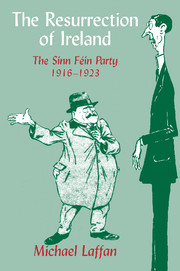Book contents
- Frontmatter
- Contents
- List of illustrations
- List of figures and tables
- Preface
- Note on the text
- List of abbreviations
- PROLOGUE: BEFORE THE EASTER RISING
- THE IRISH REVOLUTION, 1916–1923
- 2 Rebellion and hibernation, 1916
- 3 Organizers and converts, 1917
- 4 Reverses and victory, 1918
- 5 The party: structures and members
- 6 Policy: beliefs and attitudes
- 7 War and repression, 1919–1921
- 8 Ministers and bureaucrats, 1919–1921
- 9 The treaty and the split, 1921–1922
- 10 The Pact election and the Civil War, 1922–1923
- EPILOGUE: AFTER THE CIVIL WAR
- Select bibliography
- Index
10 - The Pact election and the Civil War, 1922–1923
Published online by Cambridge University Press: 05 March 2012
- Frontmatter
- Contents
- List of illustrations
- List of figures and tables
- Preface
- Note on the text
- List of abbreviations
- PROLOGUE: BEFORE THE EASTER RISING
- THE IRISH REVOLUTION, 1916–1923
- 2 Rebellion and hibernation, 1916
- 3 Organizers and converts, 1917
- 4 Reverses and victory, 1918
- 5 The party: structures and members
- 6 Policy: beliefs and attitudes
- 7 War and repression, 1919–1921
- 8 Ministers and bureaucrats, 1919–1921
- 9 The treaty and the split, 1921–1922
- 10 The Pact election and the Civil War, 1922–1923
- EPILOGUE: AFTER THE CIVIL WAR
- Select bibliography
- Index
Summary
Many people feared that the gap between radicals and the moderates could no longer be bridged, but optimists could nonetheless take hope as each lurch towards war was matched by a corresponding move to ensure peace. Negotiations took place between the two sides and several compromise proposals were made, including the idea of holding a plebiscite on the question of the treaty. All of these were rejected by the republicans. On 1 May a group of ten senior army officers, five from each camp, recognized ‘the fact – admitted by all sides – that the majority of the people of Ireland are willing to accept the Treaty’ and suggested that an agreed election should be held. Fighting reached such a level that a few days later the two sides agreed to a ‘truce’, provoking the Leader to comment that ‘we had already drifted into civil armed strife, and the fact of establishing a Truce formally attests that fact’.
A peace committee was established by the Dáil, and its members held a total of sixteen meetings. They discussed the possibility of presenting a joint ‘national panel’ to the electorate, and while pro-treaty delegates suggested that the ratio between the two sides should be 5:3 the republicans insisted on a proportion of 6:4. Childers referred in his diary to a meeting of the republican party at which he had argued that the ‘only way of really holding Rep. position in agreed election is to have same personnel returned. Next best to have strength of existing parties returned. Any reduction hopeless.’
- Type
- Chapter
- Information
- The Resurrection of IrelandThe Sinn Féin Party, 1916–1923, pp. 386 - 430Publisher: Cambridge University PressPrint publication year: 1999



